Picture this: a family sits together at the dinner table. Everyone is physically present, but their minds are far away, scrolling, tapping, and refreshing. This scene, once uncommon, is now routine across households worldwide. Technology, once celebrated for bringing us closer, now often builds invisible walls.
As we navigate through 2025, the darker side of our digital evolution is becoming harder to ignore. This article dives deep into the numbers that reveal just how much tech is shaping, and in some cases, warping, our health, habits, and humanity.
Editor’s Choice
- 87% of Americans in 2025 report feeling “digitally drained” at least once a week due to prolonged screen exposure.
- In 2025, the average US adult spends 9.6 hours per day on digital devices, up from 8.3 hours in 2023.
- 46% of Gen Z adults in 2025 say they experience tech-related anxiety when away from their phone for more than 30 minutes.
- 32% of parents in the US now monitor their children’s screen time using AI-based parental controls, up from 18% in 2023.
- 41% of surveyed school counselors in 2025 identify social media comparisons as a top source of teen self-esteem issues.
- The global average screen time per user hit 8.2 hours in 2025, with mobile phones accounting for 61% of that usage.
- 53% of surveyed HR leaders say that AI overuse in productivity tracking is causing employee disengagement and stress in 2025.
Computer vs. Phone: Daily Screen Time Habits
- Just 5% of people spend under 1 hour on a computer, while 9% keep their phone use just as minimal.
- Around 22% use a computer for 1–3 hours daily, but a much larger 45% do so on their phones.
- The biggest group, 47%, logs 3–8 hours per day on computers, compared to 36% who use their phones for the same duration.
- A notable 26% spend 8+ hours daily on a computer, whereas only 10% report such heavy phone use.
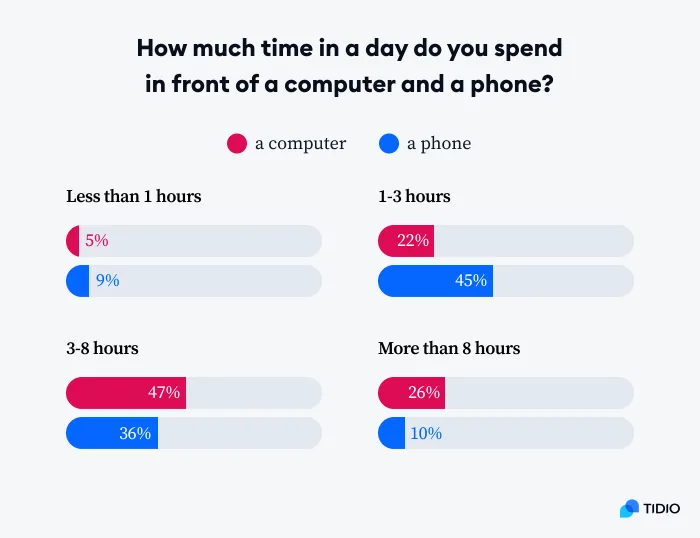
Addiction to Digital Devices
- As of 2025, 68% of US adults check their phones within 5 minutes of waking up.
- 21% of teenagers report screen addiction symptoms, including withdrawal and compulsive use, up from 15% in 2023.
- The average person in the US touches their smartphone 2,827 times per day in 2025.
- 47% of adults in 2025 admit they find it difficult to go an entire meal without looking at their phone.
- 35% of Americans acknowledge using multiple screens simultaneously (e.g., phone and TV) during leisure hours in 2025.
- In 2025, 61% of digital detox apps saw increased downloads, with the highest growth in users aged 30–45.
- Workplace productivity apps in 2025 reported that 1 in 3 users log in over 15 times daily, suggesting compulsive checking.
- 49% of adults say they feel “nervous or anxious” when they don’t have their phone nearby.
- In 2025, Americans now spend an average of 3.8 hours daily on social media platforms alone.
- Children aged 8 to 12 are spending over 5.5 hours a day on devices in 2025, exceeding pediatric recommendations by more than double.
Decrease in Empathy and Emotional Intelligence
- A 2025 study found that students who spend more than 6 hours daily on screens score 23% lower on emotional recognition tests.
- 42% of teachers in 2025 observe decreased peer empathy and communication among students compared to pre-pandemic cohorts.
- 31% of working professionals say they struggle with face-to-face communication.
- 61% of surveyed therapists in 2025 report an increase in clients experiencing emotional disconnection in their relationships.
- In romantic relationships, 29% of partners cite “device distraction” as a frequent source of conflict in 2025.
- Young adults aged 18–25 who use dating apps more than 1 hour daily showed a 19% reduction in empathy scores, based on a peer-reviewed 2025 journal.
- 48% of managers say that new hires in 2025 lack basic interpersonal skills due to overexposure to digital communication.
- 33% of social workers report that teens show reduced emotional vocabulary during in-person counseling in 2025.
- 26% of parents say their children “rarely” make eye contact during conversations.
- A 2025 education review showed a 38% drop in group collaboration skills among students participating in hybrid learning environments.
Top Reported Health Issues Linked to Smart Technology Use
- Neck and shoulder pain leads the list, affecting 37.7% of users after smart tech use.
- Sleep disturbances are close behind, troubling 36.6% of users, making it the second most common complaint.
- Headaches hit 35%, underlining a strong neurological impact.
- Loss of concentration affects 24.2%, pointing to growing cognitive challenges from screen exposure.
- Blurry vision was cited by 20.7%, signaling visual strain.
- Lower-back pain shows up in 18.7% of users, reflecting poor posture or ergonomics.
- Dry eyes are felt by 17.9%, often due to prolonged screen time.
- Obesity was linked to 13.6% of users, hinting at the sedentary impact of tech usage.
- Eye flashes were experienced by 13.3%, potentially from visual fatigue.
- Near-sightedness was reported by 10.4%, raising flags on long-term eye health.
- Transient vision loss, though less common, affected 4.2%, a serious red flag.
- Eye squinting, seen in 2.3%, may stem from close-up screen viewing.
- Seizures were rare but not absent, reported by 1.6% of users, an issue worth close attention.
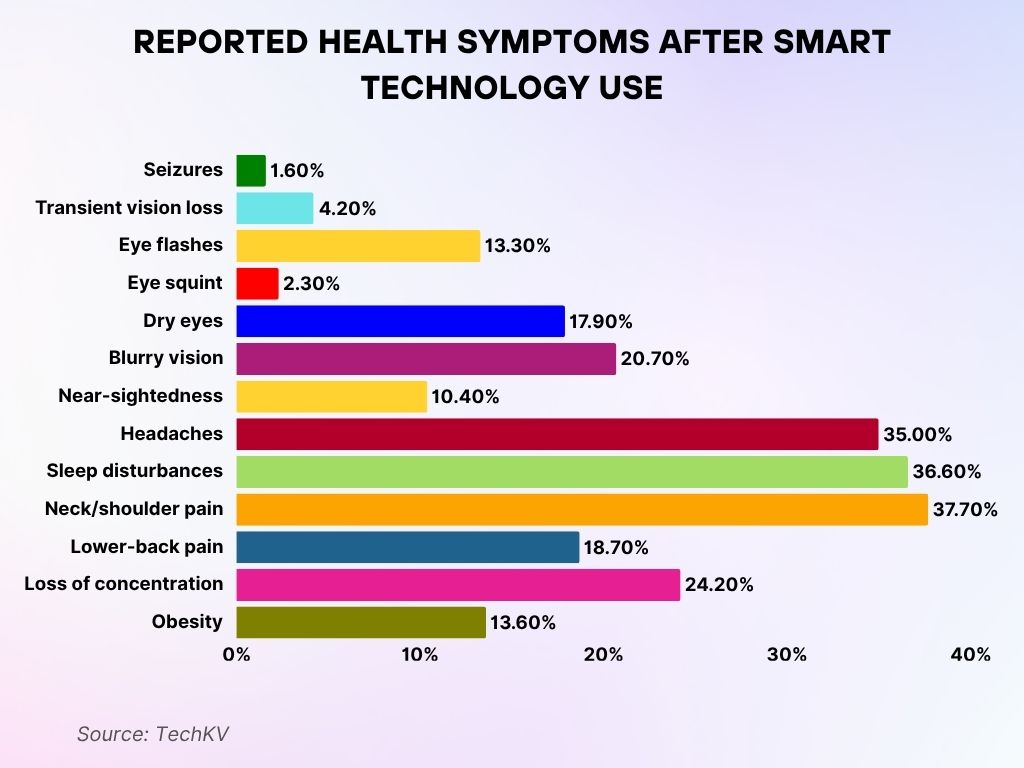
Decline in Physical Activity Due to Tech Use
- 27% of US adults are now classified as “sedentary” in 2025, directly linked to screen-heavy desk jobs.
- Daily step counts have declined to an average of 4,500 steps in 2025, compared to the recommended 10,000.
- 53% of kids aged 6–17 are not meeting the CDC’s physical activity guidelines.
- In 2025, adults aged 30–50 spend 2.7 hours more on devices daily than they do on physical movement.
- Sales of treadmill desks and under-desk ellipticals rose by 19% in 2025, a sign of increasing sedentary habits.
- 41% of surveyed adults say they’ve experienced back pain or posture issues due to prolonged screen use in 2025.
- Among teenagers, 1 in 4 reported no weekly participation in physical activities outside of school in 2025.
- 36% of pediatricians link weight gain in children to prolonged digital use in 2025.
- 18% of gym memberships in the US now include “digital movement counseling”, a 2025 trend aimed at reversing sedentary lifestyles.
- Workplace wellness programs reported a 21% drop in employee fitness engagement when screen time surpassed 9 hours a day in 2025.
Overstimulation and Attention Span Reduction
- The average human attention span in 2025 is now 7.3 seconds, down from 12 seconds in the year 2000.
- 64% of digital users in 2025 say they struggle to complete long-form tasks without getting distracted by digital alerts.
- In classrooms, 42% of educators report that students cannot stay focused for more than 10 minutes on average in 2025.
- 55% of surveyed employees report checking their email or Slack every 6 minutes throughout the workday in 2025.
- App-switching behavior has increased by 23% in 2025, with the average smartphone user toggling between apps over 100 times per day.
- 39% of parents report that their children experience sleep issues after using interactive digital content before bedtime in 2025.
- A 2025 study found that binge-scrolling on short-form video apps correlates with a 32% drop in reading comprehension retention.
- 29% of teenagers in 2025 say they “feel bored” unless stimulated by two or more devices at the same time.
- 62% of Gen Z users admit to “doomscrolling” for more than 1 hour a day in 2025, despite negative emotional outcomes.
- Neuropsychologists have observed a 14% increase in digital overstimulation diagnoses in children between the ages of 5 and 11 in 2025.
Generational Concerns About Social Media’s Health Impact
- Millennials lead the pack, with 48% worried that social media harms their physical and mental health.
- Gen Xers aren’t far behind, 37% say social media negatively impacts their well-being.
- Only 22% of Boomers share this concern, suggesting they feel less affected by social media’s influence.
- Just 15% of Matures express worry, making them the least concerned group in the survey.
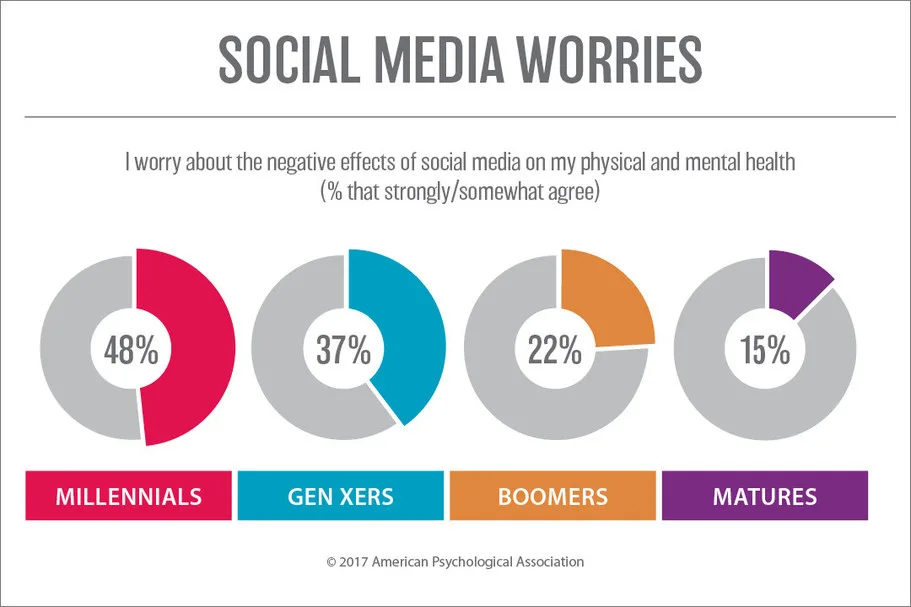
Negative Effects of AI and Automation on Employment
- 12.4 million US workers say they have been displaced or reassigned due to AI-driven automation by 2025.
- The retail sector saw a 16% reduction in entry-level roles due to AI checkout systems in 2025.
- In 2025, 43% of HR leaders use AI tools for pre-screening job applicants, cutting human review time by over half.
- 27% of blue-collar workers say they feel “professionally obsolete” due to automation expansion in 2025.
- 41% of freelancers express concern about being replaced by generative AI tools in content, design, and programming jobs in 2025.
- Among Fortune 500 companies, 31% report downsizing administrative teams due to AI workflow optimization in 2025.
- A 2025 labor report showed a 9.7% increase in tech-related job anxiety, particularly among those in clerical, legal, and finance roles.
- Government re-skilling programs in the US now cover AI-displacement aid for over 3 million citizens as of 2025.
- 54% of employees at tech firms feel “surveilled” by AI monitoring tools introduced since 2023.
- 38% of gig workers say algorithmic bias in job assignments negatively affected their income potential in 2025.
Increased Risk of Misinformation and Fake News
- In 2025, 61% of Americans say they have encountered AI-generated fake news, up from 49% in 2023.
- 45% of social media users can no longer confidently distinguish between real and fake images, according to a 2025 visual media literacy study.
- 1 in 3 US adults now get news from short-form video platforms, where fact-checking is limited or absent.
- The average user spends 19 minutes daily consuming news from sources flagged for misinformation in 2025.
- 72% of teachers report needing to teach media literacy skills more actively in response to rising misinformation in 2025.
- Deepfake content on social platforms increased by 28% in the first half of 2025 alone.
- 52% of political misinformation in 2025 is now generated or amplified by AI bots, according to cybersecurity analysts.
- 34% of users aged 18–29 say they have shared a news story later proven to be false.
- 16% of healthcare misinformation in 2025 is linked directly to AI-generated advice bots.
- The most commonly flagged misinformation topics in 2025 include vaccines, climate science, and AI policies.
How People View Technology’s Role in Education
- No one (0%) believes technology has an extremely negative effect on education, an encouraging sign of trust.
- The most common belief: 42% say tech has a mostly positive impact on learning.
- A solid 38% feel technology has an extremely positive influence, reflecting strong enthusiasm for its benefits in education.
- 19% take a balanced view, seeing both pros and cons in tech’s role in the classroom.
- Fewer than 1% think tech has a mostly negative impact, showing very limited skepticism.
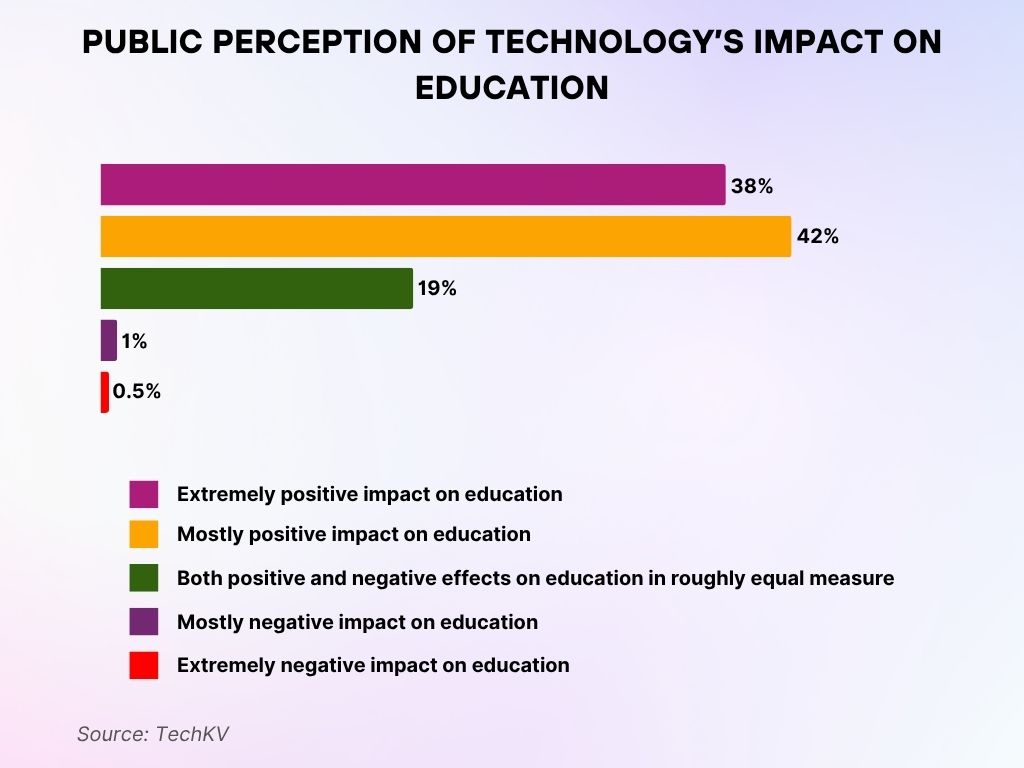
Effects of Blue Light Exposure on Eye Health
- 72% of adults in 2025 report experiencing digital eye strain at least once a week.
- Average daily screen exposure in 2025 for adults exceeds 9 hours, nearly doubling the recommended safe limit.
- 41% of ophthalmologists say they are treating more cases of Computer Vision Syndrome (CVS) in 2025 than ever before.
- 19% of teenagers now require prescription lenses due to screen-related myopia.
- A 2025 review shows that blue light filters reduce strain symptoms by 22% when used consistently for more than 6 weeks.
- 26% of workers say screen glare causes headaches and productivity dips during remote workdays in 2025.
- 38% of surveyed eye doctors recommend hourly screen breaks as standard care practice in 2025.
- Sales of blue light glasses rose by 35% in the first quarter of 2025, mostly among professionals aged 25–44.
- 14% of children aged 6–10 are already showing signs of digital eye fatigue in 2025.
- 67% of users in 2025 say they are aware of blue light exposure risks, but only 31% take any preventive measures.
Gaming Disorder and Its Prevalence
- As of 2025, 5.1% of global gamers qualify for Gaming Disorder.
- 27% of teens in the US say they play games for more than 5 hours a day, with higher rates reported in males.
- 43% of parents express concern over the impact of gaming on school performance in 2025, especially in middle school students.
- 18% of gamers aged 18–29 say they feel “unable to stop” even when games interfere with sleep or work.
- Game companies in 2025 are under pressure to implement “playtime caps”, especially in mobile games targeting children.
- 37% of therapists treating young adults report at least one case per week involving game-related compulsive behavior in 2025.
- The WHO officially reaffirmed Gaming Disorder as a diagnosable condition, urging countries to integrate it into mental health frameworks in 2025.
- 22% of esports players in the US have reported burnout or mental fatigue.
- 58% of school districts now block access to gaming platforms on public networks to limit distraction in 2025.
- 7.3 million people globally sought treatment for game-related behavioral issues in 2025, a 12% increase from the prior year.
Social Media Addiction Levels by Age Group in the US
- Across the board, 30% of US online users feel somewhat addicted, while 9% admit they’re completely addicted to social media.
- Among 18–22-year-olds, a high 40% feel somewhat addicted, though only 5% say they’re fully hooked.
- 23–38-year-olds report 37% somewhat addicted and 15% completely addicted, the highest full addiction rate among all age brackets.
- For 39–54-year-olds, 26% say they’re somewhat addicted, and 9% admit to complete addiction.
- The least impacted group? 55–64-year-olds, with only 21% somewhat addicted and a very low 1% completely addicted.
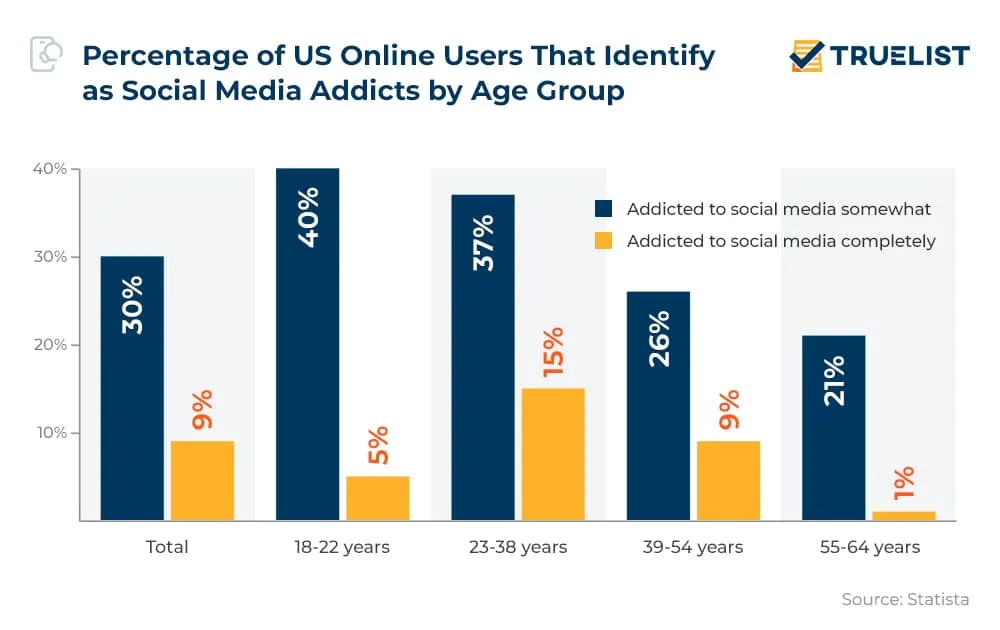
Psychological Impact of Social Media Comparisons
- 62% of teens in 2025 say social media makes them feel worse about themselves, particularly when viewing peers’ curated lives.
- 49% of young adults report feeling inadequate or jealous after browsing platforms like Instagram or TikTok in 2025.
- Social media comparison was cited as a leading cause of depression in 29% of surveyed college students in 2025.
- In 2025, 36% of female users aged 16–24 say they’ve altered their appearance digitally before posting online.
- 24% of Gen Z users admit they have deleted a post because it didn’t receive “enough likes” within the first hour in 2025.
- A major US therapy network reported a 44% increase in sessions addressing social media-related self-esteem issues in 2025.
- 19% of surveyed users say they’ve experienced sleep disruption after obsessively checking social metrics in 2025.
- 71% of mental health professionals in 2025 believe comparison culture online is now a “top five trigger” for anxiety.
- Teens spending more than 3 hours/day on appearance-focused platforms are 2.3x more likely to report body dissatisfaction in 2025.
- 51% of parents express concern that their child’s self-worth is linked to social media engagement in 2025.
Increased Tech Dependence in Early Childhood
- 38% of children aged 3–6 use a digital device daily for 2+ hours in 2025.
- Pediatricians warn that early exposure to tablets and phones can delay language development, affecting 1 in 5 children in 2025.
- 34% of surveyed kindergartens now use tablets as part of daily activities, prompting concern over screen learning reliance in 2025.
- 21% of toddlers are able to navigate YouTube or streaming apps independently in 2025.
- A 2025 study found that early screen use was linked to lower attention control scores at age 7.
- 46% of parents in 2025 use screens to pacify children during meals, increasing dependency behaviors.
- Digital storytime apps surpassed traditional children’s book sales for the first time in 2025, with a 17% lead.
- 29% of preschool teachers observed reduced fine motor skills due to decreased use of physical learning tools in 2025.
- 15% of children aged 2–4 show signs of screen-induced tantrums or mood changes, according to a 2025 behavioral review.
- The American Academy of Pediatrics reaffirmed in 2025 that screen time for children under 5 should be limited to 1 hour per day, but compliance remains low.
Smartphone Habits of UK Users: When and Where They’re Checking
- 54% of people never reach for their phones when waking up at night, but 17% admit they frequently do.
- While watching TV, 54% check their phones very or fairly frequently, and just 14% say they never do.
- At work, only 26% avoid their phones completely, while 35% use them frequently on the job.
- During dinner out, 46% keep their phones away, while 43% still check them occasionally.
- Before going to sleep, 34% never look at their phones, but 43% say they frequently do.
- At home during dinner, 46% maintain screen-free meals, but 18% admit to frequent phone use.
- Behind the wheel, 84% of people say they never use their phones while driving, though a risky 4% admit to doing so frequently.
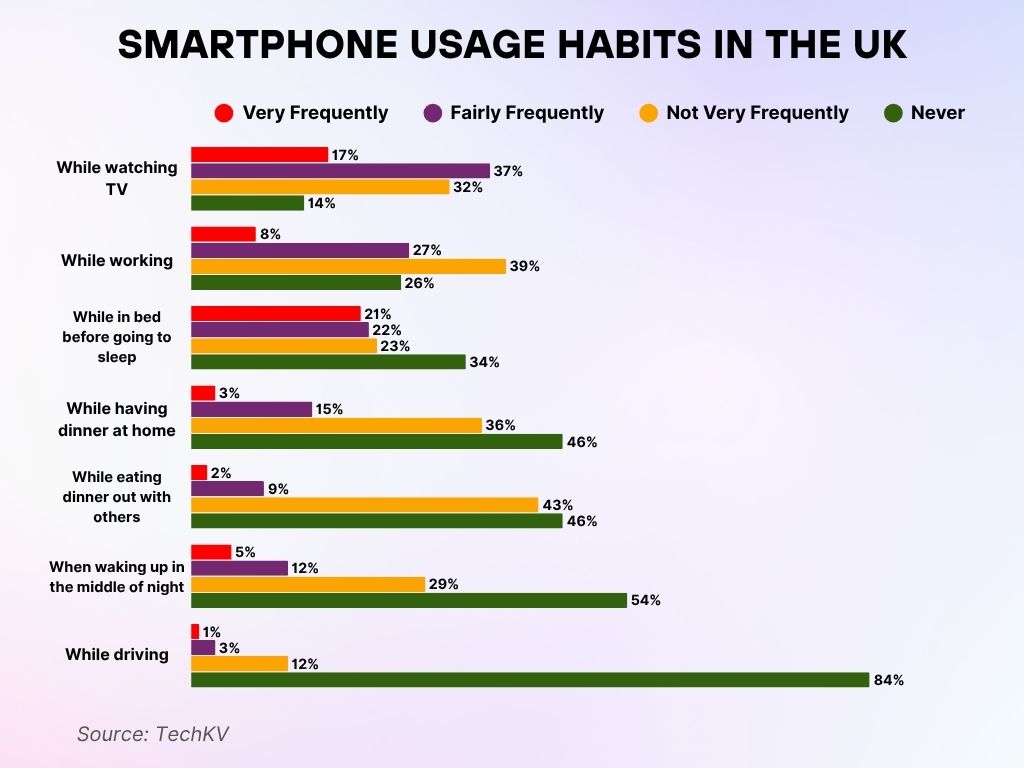
Negative Impact on Language and Communication Skills
- In 2025, 41% of college instructors say students increasingly rely on text abbreviations and emojis in formal assignments.
- A linguistic study showed a 22% decline in average vocabulary richness among teens active on digital platforms in 2025.
- 58% of HR recruiters report that entry-level candidates struggle with verbal communication during interviews in 2025.
- 26% of children aged 7–10 use devices during family conversations, disrupting language modeling at home in 2025.
- Speech therapists observed a 19% increase in referrals related to delayed expressive language in early learners in 2025.
- 31% of parents say their children prefer texting over talking, even in face-to-face settings in 2025.
- 37% of surveyed teachers report that students struggle to construct complete verbal responses during oral exams in 2025.
- 42% of high school seniors cite chat-based learning tools as their primary form of studying in 2025.
- Voice notes have overtaken traditional phone calls among users aged 18–30 in 2025, changing speech patterns and tone.
- A 2025 language trends report found a 28% increase in the use of internet slang in professional emails by individuals under 35.
Tech-Related Road Accidents and Distractions
- In 2025, 14.2% of US traffic accidents were linked to mobile phone use while driving.
- 29 states introduced or expanded digital driving laws in 2025 to curb rising distraction-based collisions.
- 42% of drivers under age 30 admit to checking notifications at red lights in 2025, despite legal restrictions.
- Car insurance companies report a 17% rise in claims with “phone distraction” as a contributing factor in 2025.
- 9% of pedestrian fatalities are now associated with driver screen distraction, according to NHTSA data in 2025.
- Dashcam footage reviewed in 2025 revealed that 1 in 6 commercial drivers glance at a phone while operating a vehicle.
- 53% of drivers aged 18–24 admit to using navigation apps and texting simultaneously in 2025.
- 31% of ride-share drivers said they feel pressured to check new fares or tips mid-trip, leading to increased distraction in 2025.
- 68% of new vehicles sold in 2025 include in-dash entertainment systems, raising concerns about the oversaturation of on-road stimuli.
- The US Department of Transportation allocated $74 million in 2025 to fund AI-based driving alert systems to detect distracted behavior.
Ethical Concerns Around Algorithmic Bias
- In 2025, 63% of US consumers express concern over bias in AI decision-making systems, especially in hiring and finance.
- 21% of facial recognition errors recorded in law enforcement tools disproportionately affected people of color in 2025.
- A major credit platform was founded in 2025 to flag women at 15% higher risk of loan default due to flawed training data.
- 48% of AI hiring tools reviewed by ethics boards in 2025 failed to meet basic fairness standards.
- 36% of healthcare diagnostic algorithms are still under investigation in 2025 for producing skewed results based on race or gender.
- In education, 22% of AI grading tools showed inconsistencies when evaluating essays written in non-native English in 2025.
- 41% of major tech firms now maintain an AI ethics board, but only 17% of them publish full transparency reports as of 2025.
- 19% of surveyed job seekers in 2025 say they were unfairly screened out by automated systems before interviews.
- A federal task force was established in 2025 to monitor algorithmic discrimination across sectors.
- 73% of Americans support increased regulation of AI, believing current safeguards are insufficient in 2025.
Recent Developments
- The WHO released a new Digital Health Risk Index in 2025, aimed at helping governments benchmark technology’s impact on public wellness.
- 38 countries adopted new “Right to Disconnect” laws in 2025, protecting workers from off-hours digital demands.
- A major social media platform rolled out “comparison warning alerts” in 2025 to flag image-altering content for younger users.
- Wearable tech companies introduced real-time mental fatigue sensors to alert users when screen use becomes unhealthy in 2025.
- 25% of Fortune 500 companies now include “digital wellbeing” scores in performance reviews.
- The CDC issued its first comprehensive “Screen Time & Youth Report” in 2025, highlighting long-term behavioral risks.
- Education systems in 6 US states integrated media literacy and AI ethics as mandatory courses for middle school students in 2025.
- Major tech conferences in 2025 included “ethical by design” workshops focused on minimizing harm in AI product development.
- App marketplaces began labeling software with “wellbeing impact scores”, ranking them on addiction and distraction potential in 2025.
- Mental health organizations now widely deploy AI chatbots for real-time triage, but with usage disclaimers made mandatory in 2025.
Conclusion
The stats don’t lie: while technology has enriched our lives in countless ways, it’s also complicating how we think, connect, and live. From toddlers tapping screens before they can speak to adults struggling with empathy in a hyper-connected world, 2025 paints a complex picture of digital dependence.
This isn’t about fear, it’s about awareness. As technology continues to evolve, our understanding of its impact must evolve, too. With the right strategies, policies, and daily habits, we can harness innovation without sacrificing what makes us human.
